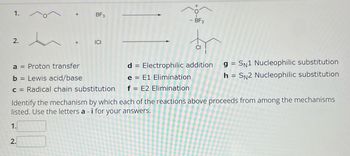
Chemistry
10th Edition
ISBN: 9781305957404
Author: Steven S. Zumdahl, Susan A. Zumdahl, Donald J. DeCoste
Publisher: Cengage Learning
expand_more
expand_more
format_list_bulleted
Concept explainers
Question

Transcribed Image Text:1.
2.
BF3
a = Proton transfer
b = Lewis acid/base
c = Radical chain substitution
1.
ICI
2.
BF3
Identify the mechanism by which each of the reactions above proceeds from among the mechanisms
listed. Use the letters a -i for your answers.
d = Electrophilic addition g = SN1 Nucleophilic substitution
e E1 Elimination
h = SN2 Nucleophilic substitution
f = E2 Elimination
Expert Solution
This question has been solved!
Explore an expertly crafted, step-by-step solution for a thorough understanding of key concepts.
Step by stepSolved in 3 steps with 2 images

Knowledge Booster
Learn more about
Need a deep-dive on the concept behind this application? Look no further. Learn more about this topic, chemistry and related others by exploring similar questions and additional content below.Similar questions
- 1. 2. BH3 a Proton transfer b = Lewis acid/base 1. N(CH3)3 2. NaOEt EtOH CH3 H₂B-N-CH3 CH3 + NaCl + e Electrophilic addition f = E1 Elimination g = E2 Elimination. HOEt Identify the mechanism by which each of the reactions above proceeds from among the mechanisms listed. Use the letters a - j for your answers. h = SN1 Nucleophilic substitution i = SN2 Nucleophilic substitution j = Electrophilic aromatic substitution 12aarrow_forward(10) The following can undergo 1,2- or 1,4-addition reactions. Predict the major organic product from each reaction. 1. LiAlH4 2. H+ 1. CH3S- +Na 2. H+ 1. KCN 2. H+ 1. (CH3CH₂)2CuLi 2. H 1. CH3CH₂MgCl 2. H+arrow_forward1. 2. CH3 a 1. www 2. CH3 + Br a = Proton transfer b = Lewis acid/base c = Radical chain substitution HCI مار Na benzene, reflux CH₂ d CI d Radical chain addition e = Electrophilic addition f = E1 Elimination 4 HO-CH + NaBr Identify the mechanism by which each of the reactions above proceeds from among the mechanisms listed. Use the letters a - i for your answers. g = E2 Elimination h = SN1 Nucleophilic substitution i = SN2 Nucleophilic substitutionarrow_forward
- 1. 2. H₂C 1. MeO 2. -CH3 H₂O a = Proton transfer b = Lewis acid/base c = Radical chain substitution H3PO4 80° MeO CH3 H₂COM₂ CH3 d = Radical chain addition e = Electrophilic addition f = E1 Elimination H₂O Identify the mechanism by which each of the reactions above proceeds from among the mechanisms listed. Use the letters a - i for your answers. g = E2 Elimination h = SN1 Nucleophilic substitution i = SN2 Nucleophilic substitutionarrow_forwardQuestion 3arrow_forward1. 2. Ph 1. Ph OH a Proton transfer b = Lewis acid/base c = Electrophilic addition 2. + Na CN NMe₂ DMF H₂SO4 Ph Ph H3C H CH3 H CN OH NM²₂ Tamoxifen anti (brest) cancer drug Ph d E1 Elimination = e = E2 Elimination Ph NMe₂ The rections above involve synthesis or reactions of alcohols and ethers. Identify the mechanism by which they proceed from among the mechanisms listed. Use the letters a- g for your answers. f = SN1 Nucleophilic substitution gSN2 Nucleophilic substitutionarrow_forward
- Criteria for satisfactory score Reactants, products, and reagents that complete a reaction scheme must specific compounds, not generic categories. Reagents and structures must be valid Lewis structures. Tasks Complete the synthetic sequences by drawing products/substrates/reagents in empty spaces in reactions below. 1. t-BUOK, heat 2. Br2 (1 equiv) methanol (solvent) Br 1. O3 2. Me2S 1. Hg(OAc)2, H2O 2. NABH4arrow_forwardIdentify the mechanism by which each of the reactions above proceeds from among the mechanisms listed. Use the letters a - i for your answers.arrow_forward
arrow_back_ios
arrow_forward_ios
Recommended textbooks for you
 ChemistryChemistryISBN:9781305957404Author:Steven S. Zumdahl, Susan A. Zumdahl, Donald J. DeCostePublisher:Cengage Learning
ChemistryChemistryISBN:9781305957404Author:Steven S. Zumdahl, Susan A. Zumdahl, Donald J. DeCostePublisher:Cengage Learning ChemistryChemistryISBN:9781259911156Author:Raymond Chang Dr., Jason Overby ProfessorPublisher:McGraw-Hill Education
ChemistryChemistryISBN:9781259911156Author:Raymond Chang Dr., Jason Overby ProfessorPublisher:McGraw-Hill Education Principles of Instrumental AnalysisChemistryISBN:9781305577213Author:Douglas A. Skoog, F. James Holler, Stanley R. CrouchPublisher:Cengage Learning
Principles of Instrumental AnalysisChemistryISBN:9781305577213Author:Douglas A. Skoog, F. James Holler, Stanley R. CrouchPublisher:Cengage Learning Organic ChemistryChemistryISBN:9780078021558Author:Janice Gorzynski Smith Dr.Publisher:McGraw-Hill Education
Organic ChemistryChemistryISBN:9780078021558Author:Janice Gorzynski Smith Dr.Publisher:McGraw-Hill Education Chemistry: Principles and ReactionsChemistryISBN:9781305079373Author:William L. Masterton, Cecile N. HurleyPublisher:Cengage Learning
Chemistry: Principles and ReactionsChemistryISBN:9781305079373Author:William L. Masterton, Cecile N. HurleyPublisher:Cengage Learning Elementary Principles of Chemical Processes, Bind...ChemistryISBN:9781118431221Author:Richard M. Felder, Ronald W. Rousseau, Lisa G. BullardPublisher:WILEY
Elementary Principles of Chemical Processes, Bind...ChemistryISBN:9781118431221Author:Richard M. Felder, Ronald W. Rousseau, Lisa G. BullardPublisher:WILEY

Chemistry
Chemistry
ISBN:9781305957404
Author:Steven S. Zumdahl, Susan A. Zumdahl, Donald J. DeCoste
Publisher:Cengage Learning

Chemistry
Chemistry
ISBN:9781259911156
Author:Raymond Chang Dr., Jason Overby Professor
Publisher:McGraw-Hill Education

Principles of Instrumental Analysis
Chemistry
ISBN:9781305577213
Author:Douglas A. Skoog, F. James Holler, Stanley R. Crouch
Publisher:Cengage Learning

Organic Chemistry
Chemistry
ISBN:9780078021558
Author:Janice Gorzynski Smith Dr.
Publisher:McGraw-Hill Education

Chemistry: Principles and Reactions
Chemistry
ISBN:9781305079373
Author:William L. Masterton, Cecile N. Hurley
Publisher:Cengage Learning

Elementary Principles of Chemical Processes, Bind...
Chemistry
ISBN:9781118431221
Author:Richard M. Felder, Ronald W. Rousseau, Lisa G. Bullard
Publisher:WILEY